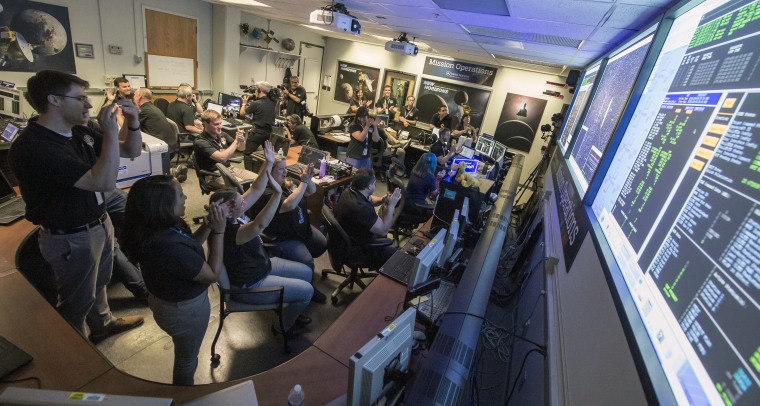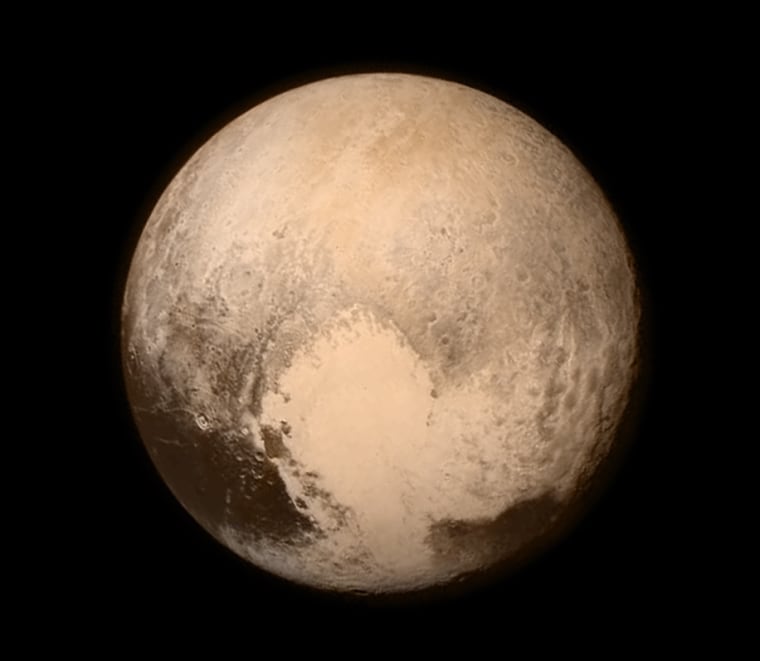LAUREL, Md. — Signals from a spacecraft 3 billion miles away swept over Earth on Tuesday, confirming that NASA's New Horizons probe survived its history-making Pluto flyby.
The radio signals were received by a Deep Space Network antenna in Spain four and a half hours after they were sent out from the spacecraft at the speed of light, and a full 13 hours after the probe made its close pass. But they electrified hundreds of VIPs, journalists and Pluto fans here at Johns Hopkins University Applied Physics Laboratory as if the main event had just happened.
The audience stood up, applauded and waved American flags as, one by one, mission controllers reported "nominal" status for the hardware that was their responsibility.
"We have a healthy spacecraft, we've recorded data of the Pluto system, and we're outbound from Pluto," mission operations manager Alice Bowman declared just before 9 p.m. ET, setting off the last and biggest round of applause. She said the procedure went "just like we planned it, just like we practiced."
The transmission not only assured the team that the piano-sized spacecraft was in good health, nine and a half years after its launch, but it also suggested that groundbreaking images and observations of Pluto and its moons would be streaming in from New Horizons for months to come.
The flyby actually took place at 7:49 a.m. ET Tuesday, with New Horizons traveling at more than 30,000 mph (50,000 kilometers per hour) and coming within 7,750 miles (12,500 kilometers) of the dwarf planet's mottled surface. But the spacecraft was so busy making observations that it couldn't turn its antenna back toward Earth to send the all-clear signal until hours later.
To mark the occasion, NASA released a colorized view of the dwarf planet that was sent back to Earth before New Horizons went out of contact on Monday night. The picture featured the dwarf planet's bright heart-shaped region as well as the head of a dark "whale" feature. It was part of a "fail-safe" series of observations that were made just in case the spacecraft suffered a catastrophic failure during the flyby.
After the image was released, mission scientists went into high gear, pointing to features in the photo such as a bright bull's-eye crater nicknamed the "whale's blowhole," a point that may be a frost-capped peak, linear streaks that may (or may not) hint at tectonic activity — and mounds of icy material on the surface.
The mission's principal investigator, Alan Stern of the Southwest Research Institute, was asked whether it was now fair to say that it snows on Pluto. "It sure looks that way," he replied.

Related: 5 Things We Just Found Out About Pluto and Charon
Stern said it felt good to get through the flyby.
"It's a moment of celebration, because we've just done the 'anchor leg,'" Stern said on NASA TV, using a track-and-field metaphor. "We have completed the initial reconnaissance of the solar system."
No new images were transmitted on Tuesday — just the telemetry reporting the spacecraft's health. The first images and data from the close flyby are due to be received and unveiled on Wednesday, and they'll continue coming down for the next 16 months.
The mission quickly captured the popular spotlight, in forms ranging from a Google Doodle and a New Yorker cartoon, to NASA astronaut Scott Kelly's salute from the International Space Station, to a congratulatory tweet from President Barack Obama. "It's a great day for American discovery and leadership," Obama wrote.

Related: Neil deGrasse Tyson Says New Horizon Is a 'Triumph'
John Grunsfeld, NASA's associate administrator for science, said the heart of New Horizons' appeal is its status as the first mission to the last frontier — that is, the icy worlds that lie beyond the orbit of Neptune, in a region known as the Kuiper Belt. "Pluto is kind of a capstone of our solar system exploration, and also opening up this new realm," he said.
Among those on hand for Tuesday night's "Phone Home" celebration were the children of late astronomer Clyde Tombaugh, who discovered Pluto in 1930; the daughter of the late astronomer Gerard Kuiper, after whom the Kuiper Belt is named; Jim Christy, the discoverer of Charon, Pluto's largest moon; and a group of 9-year-old children who were born on the day of New Horizons' launch.
NASA Administrator Charles Bolden was on hand as well, and hailed the flyby as a demonstration of "how great our nation is." Intentionally or not, he also touched on the controversy over the International Astronomical Union's classification of Pluto as a "dwarf planet" rather than a full-fledged planet in 2006, just months after New Horizons was launched.
"With this mission, we have visited every single planet in our solar system," Bolden said. He didn't include the "dwarf" label.
Related: Will New Horizons Restore Pluto to Planethood?
The next round of images from NASA's New Horizons mission to Pluto and its moons will be unveiled during a news briefing at 3 p.m. ET Wednesday. The briefing will air on NASA TV.
